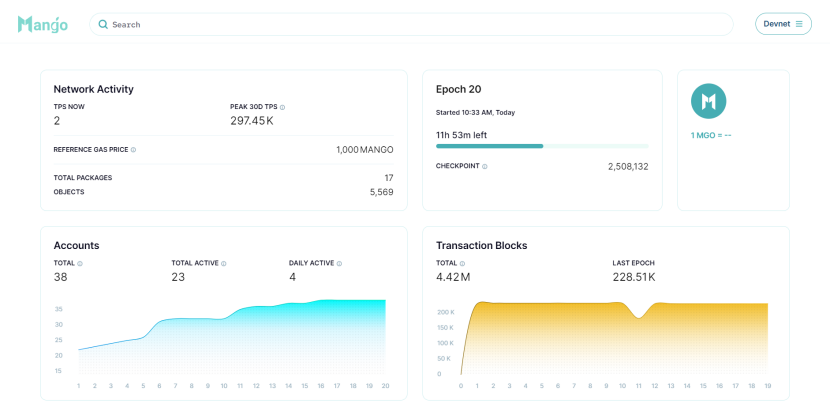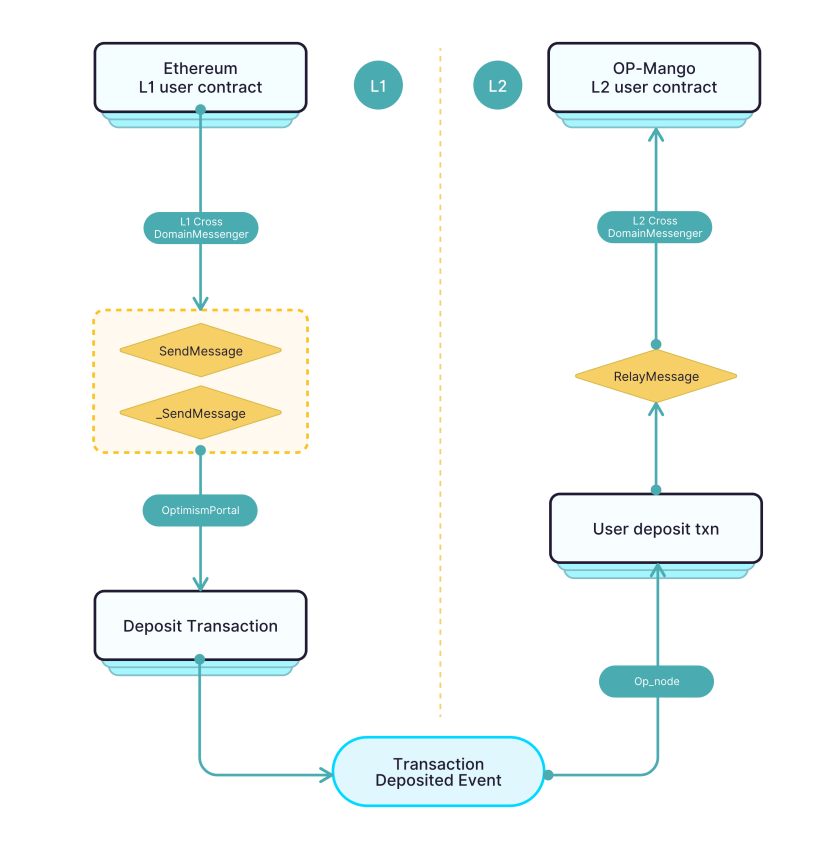Detailed explanation of Mango Network: Multi-VM full-chain infrastructure network competes for the new L1 track
Multi-VM architecture is the solution to the currentBlockchain扩展性和性能瓶颈的最优方案,并正在成为一种新趋势,推动着链上生态的深度融合。Mango Network作为创新的全链基础设施网络,融合了OPStack 技术和MoveVM的核心优势,构建了一个支持跨链通信和多虚拟机互操作性的高效区块链网络。Mango Network凭借更好的兼容性、扩展性、开发者友好度、多链互操作行和庞大的未来潜力,获得市场普通认同。
多VM架构:区块链行业的冉冉新星
Amid the craze of Token2049 in Singapore, the blockchain industry is undergoing a profound reflection and transformation. On the surface, the industry seems to be attracted by the prosperous scene of "all chains are launched at the same time", but with the diversification and complexity of the decentralized application ecosystem, the need to break down the barriers between blockchain ecosystems and promote cross-chain compatibility has become more urgent. Today, the priority of "compatibility" has surpassed "high performance" and has become the core challenge of the development of the chain ecosystem.
For a long time, many organizations in the blockchain field have regarded parallel execution (parallel EVM) as a key technology to improve network performance. Parallel EVM networks such as Artela, MegaETH, and Sei aim to promote the popularization of new applications by improving throughput and transaction processing capabilities. Parallel EVM does perform well in processing high-volume environments, especially for applications such as DeFi and DEX that have strict requirements for high performance.
However, with the diversification of blockchain ecology, simply relying on performance improvement can no longer meet industry needs. The future development of the on-chain ecology depends not only on the improvement of transaction processing capabilities, but also on enhancing the compatibility of the ecology, especially in the complex environment of cross-chain and multi-chain, this demand is more prominent.
As the importance of cross-chain interaction and interoperability becomes increasingly apparent, the multi-VM architecture (Multi-VM) has gradually emerged as a key technology to meet these challenges with its flexibility and adaptability across ecosystems. Against the backdrop of the rapid expansion of the on-chain application ecosystem, the multi-VM architecture is becoming the focus of competition in the L1 track, bringing more possibilities and innovation opportunities to the future blockchain ecosystem. This trend marks the transformation of the blockchain industry from the single pursuit of "high performance" to "all-round ecological integration", and the multi-VM architecture is the core carrier of this vision.
In this context, the multi-VM architecture is gaining more and more attention and adoption with its multiple technical advantages. By supporting multiple virtual machines (such as EVM, MoveVM, WASM, etc.), the multi-VM architecture not only provides developers with more tool choices and flexibility, but also significantly lowers the development threshold and attracts developers from different technical backgrounds. This brings stronger scalability and interoperability to the platform, especially in the interaction between heterogeneous chains, bridging the barriers between different chains and improving the liquidity of on-chain capital.
Multi-VM architecture projects represented by Mango Network have created a full-chain infrastructure network that supports cross-chain communication and multi-virtual machine interoperability by integrating the core advantages of OPStack technology and MoveVM. This innovation not only improves the scalability of the platform, but also promotes the interoperability of heterogeneous chains, solving the long-standing problem of fragmented on-chain liquidity.
In the current blockchain market, the development of cross-chain applications has put forward higher requirements for the efficient integration of the ecosystem. Multi-VM projects support multiple smartcontractLanguages and virtual machines break down the technical barriers between different chain ecosystems, providing a broader space and flexibility for future decentralized applications. For large-scale decentralized applications, compatibility will be a key factor in determining their success. This compatibility will not only provide impetus for the sustainable development of the blockchain ecosystem, but will also lead to the birth of more innovative applications. As the market matures further, the multi-VM architecture is expected to occupy an important position in the competition of the L1 track and become the core force driving the innovation of the next generation of blockchain technology.

Mango: Excellent architecture achieves multi-VM full-chain infrastructure network
Mango Network's Layer 1 solution is strongly supported by the Move language, providing developers and users with aSafety, modular and high-performance Web3 infrastructure. Its transaction processing speed is as high as 297,450 times (TPS), demonstrating excellent performance while maintaining a high degree of standardization, scalability and interoperability.

Mango Network Devnet Up to 297.45K TPS
Mango Network的Layer 2解决方案,OP-Mango基于OPStack开发,提供了强大的跨链通信能力,这是其与传统Layer 2解决方案的显著区别。它通过跨链通信合约连接以太坊网络的EVM层和Mango网络的MoveVM层,既保留了对EVM智能合约的兼容性,又通过MoveVM实现更加灵活、SafetyThis design allows developers to take advantage of the advantages of both virtual machines, expand application scenarios, and provide users with richer services. Mango Network achieves cross-chain communication and multi-virtual machine interoperability by integrating MoveVM and EVM virtual machines.

Mango Network: Multi-VM full-chain infrastructure network
Mango Network's multi-VM full-chain infrastructure relies on the following key technical principles:
1. Principle of parallel execution of multiple virtual machines
Mango Network uses two virtual machines, MoveVM and EVM, to jointly process transactions and smart contract calls on the chain. Different virtual machines are responsible for different types of contracts and operations, but they are connected through cross-chain communication bridges to achieve full-chain operation coordination.
-
MoveVM: MoveVM focuses on handling asset management, complex contract logic, and parallel operation capabilities. The principle of parallel execution is that MoveVM can dynamically schedule transactions based on the state dependencies between contracts and transactions, ensuring that non-conflicting transactions can be executed simultaneously. This not only improves the transaction throughput of the network, but also enhances the overall execution efficiency.
-
EVM: EVM is the core virtual machine in the Ethereum ecosystem, compatible with a wide range of smart contracts. By combining with OP-Mango, EVM can pass its transactions and contract events to MoveVM for processing, thus realizing the calling of cross-chain contracts.
2. Principles of inter-VM communication and data transmission
The core challenge of multi-VM infrastructure is how to achieve data sharing and contract calls between different virtual machines. Mango Network uses OP-Mango to bridge EVM and MoveVM to achieve cross-virtual machine communication and collaboration. The implementation of cross-virtual machine communication depends on three key links: event capture, data serialization and cross-chain contract calls:
-
Event Capture: When a smart contract in a virtual machine triggers an event (such as asset transfer or contract execution), the event is captured by the cross-chain sequencer. The sequencer is the component in the system responsible for monitoring changes in the state of the virtual machine.
-
Data serialization and transmission: The captured events are serialized and converted into a common format. This data format can be recognized and processed by another virtual machine. OP-Mango's cross-chain sequencer ensures that the event data in the EVM can be converted into data that can be processed by MoveVM and trigger the corresponding contract execution in MoveVM.
-
Contract mutual call: The ultimate goal of cross-chain communication is to realize contract calls between virtual machines. Through the cross-chain event transmission mechanism, the smart contracts of EVM and MoveVM can call each other to realize the complete execution of cross-chain logic. For example, when a contract on EVM completes an operation, MoveVM can receive the event and execute the corresponding operation or contract logic accordingly.
3. Layer 2 expansion and batch processing principles
In order to improve transaction processing efficiency,P-Mango adopts a Layer 2 expansion solution, which aims to process a large number of transactions off-chain and submit them to the main network for settlement on a regular basis. This architecture is based on the following technical principles:
-
-
Batch processing and assertion: OP-Mango reduces the transaction congestion problem of the main network by packaging transactions in the Layer 2 network into batches and submitting them in batches. The transaction batch contains the status changes and assertions of multiple transactions. After being submitted to the Ethereum main network, MoveVM performs the final verification and settlement in the Mango Network.
-
断言与争议解决机制:为了确保跨链交易的安全性,OP-Mango引入了断言机制。断言是对一系列交易状态的证明,当断言提交后,如果没有争议,交易将被确认。若有争议,网络可以通过验证数据链上的证据来解决纠纷。这一机制确保了跨链交易的安全性与一致性。
-
4. Principles of cross-chain asset management
The cross-chain asset management in Mango Network mainly relies on the interoperability mechanism between EVM and MoveVM to achieve the secure transfer and settlement of cross-chain assets. The core principles are as follows:
-
-
State synchronization and transfer: The cross-chain transfer of assets is synchronized through OP-Mango. Asset operations performed on EVM will be serialized and passed to MoveVM. MoveVM will update the asset status according to the event and complete the transfer of assets from EVM to MoveVM.
-
Two-way settlement: Cross-chain asset transfer and settlement is not limited to EVM to MoveVM. The asset status of MoveVM can also be passed back to EVM through the cross-chain sequencer to ensure two-way settlement between virtual machines. This process ensures the full security of cross-chain operations and the consistency of transaction data.
-
Functional core: the internal logic of Mango Network
OP-Mango is a second-layer network built on OPStack, using EVM (Ethereum Virtual Machine) compatibilityXiaobai NavigationTo process user transaction requests. Users can submit transactions and query block data through nodes. OP-Mango's nodes obtain secure transaction data from the Ethereum primary network and broadcast it through the P2P network to ensure timely synchronization of the network.
Ethereum and OP-Mango cross-chain communication
In this process, the sequencer is responsible for sorting, packaging and submitting batch data of transactions on the second-layer network. Specifically, the sequencer sorts the transactions received from users and nodes, and packages these transactions into batches and submits them to the Ethereum first-layer network.TokenMGO is used as packaging Gas. At the same time, the sequencer also performs assertion operations to submit the status updates and transaction records of the second-layer network in batches to the validators in the first-layer network to ensure that the status of the OP-Mango network is consistent with Ethereum.
The biggest feature of OP-Mango is that it closely interacts and settles with the MoveVM of the Mango Network through cross-chain communication contracts. This design allows the second-layer network to not only support EVM, but also interact with MoveVM smart contracts at the same time, thereby achieving cross-chain interoperability. In the architecture diagram, the sequencer captures events in the EVM or MoveVM and parses these events into cross-chain calls, which in turn trigger the execution of contracts in another virtual machine. Through this cross-virtual machine sequencer, OP-Mango is able to achieve contract interoperability in different virtual machine environments and complete secure settlement and data synchronization between EVM and MoveVM. Focusing on security and programmability, MoveVM provides a more flexible contract execution environment that complements the EVM layer. This design allows developers to take advantage of the advantages of both virtual machines at the same time.
Technology-driven: Architecture advantages and market positioning
In Mango Network, the security features of MoveVM are fully utilized, and its design philosophy is to minimize security vulnerabilities and runtime errors through static type checking and modular programming mode. In addition, the multi-virtual machine architecture brings higher flexibility and scalability to the network, allowing developers to freely deploy and execute smart contracts between different virtual machines, thereby promoting the development of cross-chain communication and asset interoperability.
As the first multi-virtual machine execution network using MoveVM, Mango Network successfully combines MoveVM's superior features in asset management security with its scalability in a multi-virtual machine environment. This combination not only ensures the security of assets, but also effectively solves the limitations of liquidity in the Move ecosystem by providing a diversified virtual machine execution environment, and bridges the gap with the Ethereum Virtual Machine (EVM) ecosystem. Through this innovative integration, Mango Network has achieved an organic combination of asset security and asset liquidity in the EVM ecosystem, laying a solid technical foundation for building a comprehensive on-chain basic trading facility.
-
Mango Network official
-
Web: https://mangonet.io
-
X: https://twitter.com/MangoOS_Network
-
Mail: BD@mangonet.io
-
Telegram: https://t.me/MangoNetwork
-
Discord: https://discord.com/invite/mangonetwork
-
Mango Network Dve
-
Blockchain Browser: https://mgoscan.com
-
Github: https://github.com/MangoNet-Labs
-
Developer Documentation: https://docs.mangonet.io
The article comes from the Internet:Detailed explanation of Mango Network: Multi-VM full-chain infrastructure network competes for the new L1 track
OP、SUI、DYDX等本周将迎来大额解锁,SUI将解锁约6509万美元。 作者:小白导航 coderworld 门头沟 Mt.Gox 钱包地址比特币持仓量已减少约 77% 据 Arkham 监测,自 2021 年初以来,Mt. Gox 钱包共持有 141,6…
